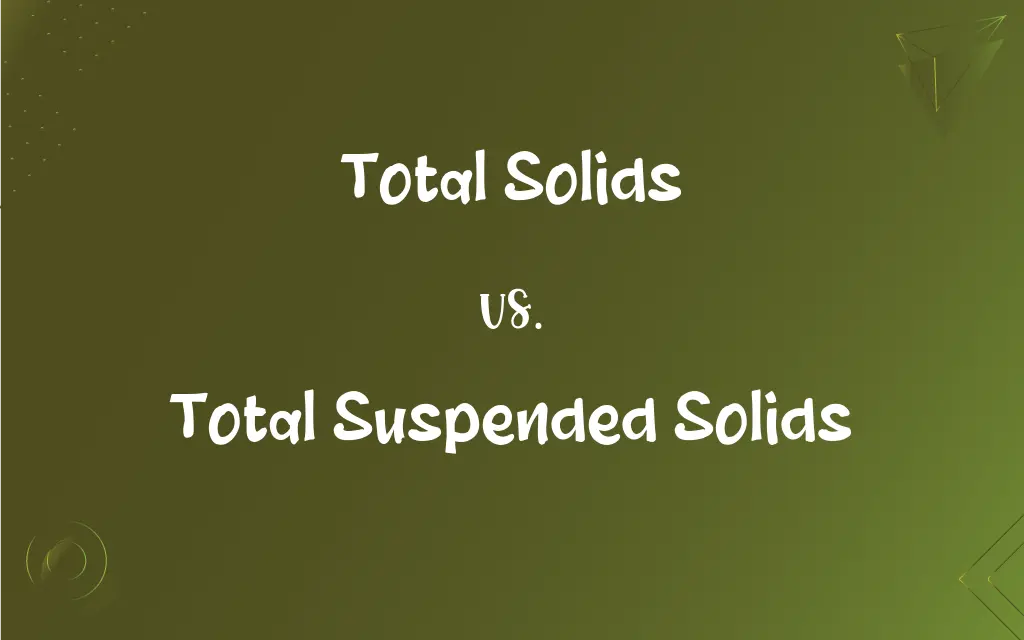Total Solids vs. Total Suspended Solids: What's the Difference?
Edited by Aimie Carlson || By Harlon Moss || Published on February 18, 2024
Total solids (TS) measure all solids in a liquid, while total suspended solids (TSS) specifically quantify solids suspended in a liquid but not dissolved.

Key Differences
Total solids in a liquid include all types of solids, both suspended and dissolved. It's a comprehensive measure of solid material in a sample. Total suspended solids, however, refer only to those solids that are not dissolved and remain suspended in the liquid, visible to the naked eye or under a microscope.
Total solids are measured by evaporating the liquid and weighing the residue that includes both dissolved and suspended components. Total suspended solids are measured by filtering the liquid to separate and weigh only the suspended particles, ignoring dissolved substances.
The measurement of total solids is crucial in understanding the overall composition of wastewater or natural water bodies. Total suspended solids are particularly significant in assessing the clarity and quality of water, as high levels of suspended solids can affect aquatic life and water usability.
In water treatment, understanding total solids is vital for designing appropriate treatment methods. The measurement of total suspended solids is crucial for evaluating the efficiency of filtration and sedimentation processes in removing particulate matter.
High total solids can indicate a high concentration of pollutants in industrial effluents or urban runoff. Elevated total suspended solids can lead to ecological disturbances, such as reducing light penetration in water and affecting photosynthesis in aquatic plants
ADVERTISEMENT
Comparison Chart
Definition
All solids in a liquid, both suspended and dissolved
Solids suspended in a liquid, not dissolved
Measurement Method
Evaporation and weighing of all residue
Filtering and weighing of suspended particles
Relevance
Indicates overall solid content in liquids
Important for assessing water clarity
Use in Water Treatment
Guides overall treatment strategy
Evaluates effectiveness of filtration processes
Environmental Impact
High levels can indicate pollution
Affects aquatic life and water usability
ADVERTISEMENT
Total Solids and Total Suspended Solids Definitions
Total Solids
Total solids include both organic and inorganic matter in a sample.
The lake's total solids reflected both natural and man-made substances.
Total Suspended Solids
Total suspended solids concentration affects aquatic ecosystems.
High total suspended solids can harm fish and underwater plants.
Total Solids
Total solids represent the total concentration of solid components in water.
The high total solids content affected the water's taste and color.
Total Suspended Solids
Total suspended solids measure particulate matter in water that can be trapped by a filter.
Water treatment plants regularly test for total suspended solids.
Total Solids
Total solids measure the combined content of all solid matter in a liquid.
Accurate total solids measurement is crucial for water quality analysis.
Total Suspended Solids
Total suspended solids are indicative of the clarity and quality of water.
Elevated total suspended solids can lead to murky water conditions.
Total Solids
Total solids encompass all the solid material, dissolved and suspended, in a liquid.
The total solids in the industrial wastewater were alarmingly high.
Total Suspended Solids
Total suspended solids are the particles suspended, not dissolved, in a liquid.
The river's total suspended solids increased after the storm.
Total Solids
Total solids are assessed by evaporating the liquid and weighing the remaining residue.
To determine total solids, the sample was carefully dried in a lab oven.
Total Suspended Solids
Total suspended solids are primarily non-dissolved solids in a water sample.
The analysis showed a significant amount of total suspended solids in the sample.
FAQs
What are total suspended solids?
They are the particles suspended in a liquid, visible to the naked eye or under a microscope.
Why are total solids important in water analysis?
They indicate the overall solid content and potential pollutants in water.
How are total solids measured?
By evaporating the liquid and weighing the residue left behind.
What is the method for measuring total suspended solids?
By filtering the liquid to collect and weigh the suspended particles.
Can total solids affect water treatment processes?
Yes, they guide the overall strategy for treating and purifying water.
What role do total suspended solids play in environmental studies?
They're crucial for assessing the ecological impact of water pollution.
How do dissolved solids differ from suspended solids?
Dissolved solids are completely dissolved in the liquid, while suspended solids are not.
Is the measurement of total solids relevant for wastewater?
Yes, particularly for understanding the pollutant load in wastewater.
What are total solids?
They represent all types of solids, dissolved and suspended, in a liquid.
What causes an increase in total suspended solids in natural waters?
Runoff, erosion, and discharges can all increase suspended solids.
Are total solids a mix of organic and inorganic matter?
Yes, they include both types of materials in a liquid.
What does a high level of total suspended solids indicate?
It can indicate water pollution and poor water quality.
How do total suspended solids affect aquatic life?
High levels can reduce light penetration, affecting photosynthesis and aquatic habitats.
Can total solids affect the taste and odor of water?
Yes, high total solids can alter water's taste and odor.
Can high total solids be harmful to human health?
Potentially, if they include harmful pollutants or chemicals.
Do natural water bodies have total suspended solids?
Yes, all natural waters contain some level of suspended solids.
Are total suspended solids always visible in water?
Not always; some particles might be too small to see without magnification.
How do changes in total suspended solids impact water treatment?
They can necessitate adjustments in filtration and sedimentation methods.
What industries regularly monitor total solids in their wastewater?
Industries like manufacturing, mining, and agriculture.
What is the significance of total solids in environmental regulations?
They are often regulated to control water pollution and protect ecosystems.
About Author
Written by
Harlon MossHarlon is a seasoned quality moderator and accomplished content writer for Difference Wiki. An alumnus of the prestigious University of California, he earned his degree in Computer Science. Leveraging his academic background, Harlon brings a meticulous and informed perspective to his work, ensuring content accuracy and excellence.
Edited by
Aimie CarlsonAimie Carlson, holding a master's degree in English literature, is a fervent English language enthusiast. She lends her writing talents to Difference Wiki, a prominent website that specializes in comparisons, offering readers insightful analyses that both captivate and inform.







































































